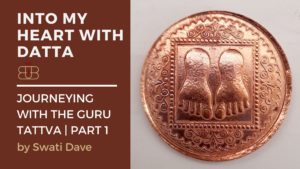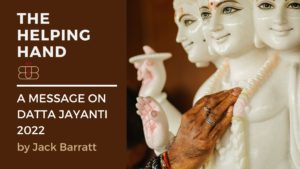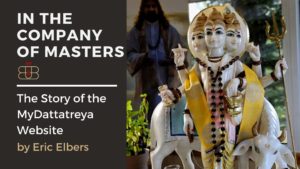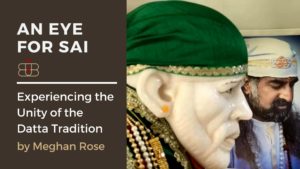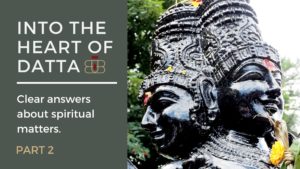Overview and Significance
Gajanan Maharaj was an Indian Guru, saint, and mystic believed to be an incarnation of the Hindu Deity, Lord Ganesha. His origins remain uncertain. He first appeared at Shegaon, Maharashtra, as a young man in his twenties, probably during February 1878. He breathed his last on September 8, 1910, by attaining Sajeevana Samadhi, a process of voluntary withdrawal from one’s physical body.
In this period of thirty-two years, he performed many miracles. Gajanan Maharaj was an ardent user of marijuana and hashish, exemplified in almost all available images in the public domain from the time of his attaining samadhi. Even the temple premises where he attained samadhi had a smoking choola as a symbolic representation. Very few accurate details of Maharaj’s life are available. He once visited Nashik, Maharashtra, and the surrounding pilgrimage sites, including Kapiltirtha. He probably lived at Kapiltirtha for around twelve years. Contemporaries of Gajanan Maharaj identified him by several names such as Gin Gine Buwa, Ganpat Buwa, and Awaliya Baba, etc. The name Gajanan Maharaj was first suggested in 1905 by Dadasaheb Khaparde of Amravati since He was often heard addressing Himself as ‘Ganya.’
According to his biography, Shree Gajanan Vijay, Gajanan Maharaj considered a few other spiritual personalities such as Narasingji, Vasudevanand Saraswati (Tembe Swami Maharaj) and Sai Baba of Shirdi as his brothers. The biography also claims that Gajanan Maharaj appeared as the Hindu deity Vitthala in Pandharapur for his one devotee Bapuna Kale. He is also believed to have appeared as Samartha Ramdas for another devotee. Gajanan Maharaj still manifests himself at Shegaon to those who believe in his existence.
Life History
There is hardly any authenticated information about the early life of Shri Gajanan Avadhut, popularly known as Gajanan Maharaj. His place and date of birth, parentage, etc., are shrouded with mystery, although people speculate that he was born in a place named Sajjangarh in Maharashtra. Quite often, the terminal points (birth and death) in the lives of spiritually advanced souls are mystical.
Shri Gajanan did not reveal his past nor encouraged people to search for it. However, Shri Gajanan Avadhoot was first noticed collecting leftover food items in a garbage dump on the outskirts of village Shegaon in Maharashtra by Bankatlal Aggarwal. The Maharaj was in a superconscious state with a shining and very healthy body, without a sense of body and no clothes.
Bankatlal, who had experienced earlier associations with spiritually advanced persons, sensed that the seemingly crazy person collecting food from the dustbin might be a ‘Siddha.’ It was 23rd February 1878. Bankatlal, when he, along with his friend Damodar Pant Kulkarni, approached Maharaj with humility and asked, ‘Maharaj, why are you eating leftover food? If you are hungry, I will certainly make arrangements for you.’ However, Maharaj paid no heed to his words and continued to eat his food in a state of utter detachment. Seeing this, Bankatlal ran to the Ashram situated nearby, collected whatever food he could, and came back to Maharaj. As he offered food, Maharaj mixed up all the food items and gulped them down.
Bankatlal, after that, went away to collect some drinking water. By the time he returned, he was shocked to see Maharaj happily drinking water from the reservoir meant for cattle. Bankatlal became convinced that he was in the presence of no ordinary mortal but a highly evolved spiritual entity. He prostrated in reverence and asked for blessings. By the time he lifted his head, Maharaj had vanished from there. Bankatlal was extremely sad and depressed at the sudden disappearance of Maharaj, but little did he know that Gajanan Avadhut was his own Sadguru (True Master) who had himself shown to him at that time. His mind could think of nothing except Gajanan Avadhut and searched for him the whole day without any success. However, he again found Maharaj in the evening when he went to the old Shiva temple to worship. He was delighted to see him and requested Baba to come and stay in his house in an emotionally choked voice. Maharaj, at his request, came to his home from where his divine play (Leela) started.
Maharaj often used to slip out quietly. Bankatlal then searched for him strenuously and would request him to come back. After a short stay at Khodgaon, the Maharaj returned to Shegaon. There he moved to the house of one Khandu Patil. One day, about ten South Indian Brahmins, intent to earn some money, came to Maharaj while he was sleeping under a blanket cover. Suddenly Maharaj woke up during the recitation and pointed out to the Brahmins that they were mispronouncing the Vedas. Then he started reciting. Soon the Brahmins realised that Maharaj was a Saint of very high spiritual order and prostrated at his feet. Maharaj blessed them all and also gave them Dakshina.
Soon after his first appearance in Shegaon, people wondered what to call him, as nobody knew where he came from and what his lineage was. Since he continuously chanted the mantra ‘gana gana ganat botey’ people started calling him Shri Gajanan Maharaj. Often people offered him expensive clothes, ornaments, money, rich food, but he would always leave it all at the place where it was offered. He would never carry anything along with him. Most of the time, Shri Gajanan Maharaj would move around like an Avadhuta in Digambera state, i.e., without clothes, as he had conquered all the senses and reached a stage beyond them. He would eat anything, sleep anywhere and move at will to any place.
In his lifetime, he performed many miracles such as giving a fresh lease on life to one Janrao Deshmukh, lighting his clay-pipe without fire, filling a dry well with water, drawing sugar cane juice by twisting canes with his hands, curing the leprosy of a man, curing himself of the many bites of honey bees, etc. Some of these acts occurred because Shri Gajanan Maharaj knew Yoga Shastra, as revealed by his admission in the book by Shri Das Ganu Maharaj.
During a public meeting on the occasion of Shiv Jayanti, the great freedom fighter Lokmanya Tilak met Gajanan Maharaj. When Tilak delivered a charismatic speech, Maharaj predicted Tilak would get a very harsh sentence from the British Raj. Maharaj’s words did come true; however, Tilak is reported to have taken Maharaj’s blessings and Prasad (divine blessing), which helped him write his book – Shrimadh Rahasya, a summarised version of the Bhagavad Gita.
Maharaj was fond of pets – he had a dog named Motiram. When Maharaj spoke to Motiram, ‘Motiram, chillum de‘ and the dog would fetch the chillum for Maharaj. His kindness towards the cow from Balapur is also well known.
Shri Gajanan Maharaj took Samadhi on 8th September 1910. His earthly remains were buried, and a temple in his name was built on his Samadhi at Shegaon. Maharaj was prescient and had predicted his time on earth was close to getting over. So his devotees had started building the temple in his honour for some time before his Samadhi date. His Samadhi Mandir is just below the temple of Shri Ram.
Shri Gajanan Maharaj would routinely worship at the temple of Shri Ram during his lifetime. He was fond of smoking ganja in his chillum and is supposed to have also started a holy fire, or dhuni, during his lifetime. Also, close to the dhuni is the place where the devotees can see Maharaj’s paduka (wooden sandals), the temple of Vithoba and Rukmini, and the temple of Hanuman. There is an Audambar tree just near the temple of Hanuman, said to have been in existence since the days of Shri Gajanan Maharaj.
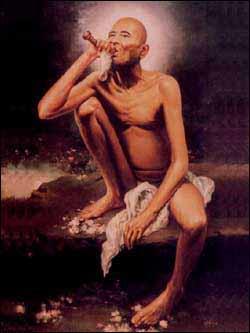
Tradition and Gurus
Shri Gajanan Maharaj is considered to be from the lineage of Lord Dattatreya as mentioned in Shripad Shri Vallabha Charitramrutam, originally authored by Shri Shankar Bhat, a contemporary of Sripad Sri Vallabha (1320-1350). In Chapter 41, it is stated that one of the two brothers of Sripad Sri Vallabha, the first Datta Avatar, would take rebirth as Swami Ramdas in the 17th century and then take rebirth as Gajanan Maharaj in Shivagaon in the 19th century. Incidentally, in Chapter 9 of Shree Gajanan Vijay Granth, Hari Bhakt Parayan (HBP) Das Ganu Maharaj illustrates the episode when Gajanan Maharaj gives darshan to Balkrishna Buwa Ramdasi in Balapur in the form of Swami Ramdas.
It is believed that Gajanan Maharaj and Sai Baba of Shirdi were under the guidance of Sri Swami of Akkalkot before they became known as Saints par excellence in their own right. Devotees will find a photo of these three saints together – Swami Akkalkot in the center and on a higher level, with Gajanan Maharaj and Sai Baba on a slightly lower level than Swami. That is the Guru Parampara.
Those who have read Sai Satcharita will recall Sai Baba offering respects to His Guru – this Guru was Akkalkot Swami. Gajanan Maharaj as a small boy, had gone to Akkalkot, and Swami Samarth, playing chess, is supposed to have remarked – ‘Ganapati Aala Re‘ in Marathi. From Akkalkot, Gajanan Maharaj went to Deo Mamlatdar in Nasik, then Karanja (where Balshastri Gatge trained Maharaj in Vedas and hymns), Akot (with Narsing Baba) for further refinement and training. Later on, Maharaj shone like the radiant sun on the horizon and brightened thousands of devotees’ lives.
Teachings
Shri Gajanan Maharaj is considered an Avadhuta, a yogi whose sole purpose is to help his devotees realise God; an ascetic who may appear to be unaware of his surroundings and the state of his body, but who truly knows the past, present, and future. Lovingly called a Mauli, a mother who just simply cares for her children’s physical and spiritual well-being (devotees) and firmly stands by them in all situations. Although many years have passed since Maharaj left his mortal coil, His devotees still experience realisation, guidance, and blessings, seen as ‘miracles.’ He is the ‘Sadhguru’ for many, leading to life-changing situations for them through difficult times.
Maharaj spoke very little during his lifetime, and even when he did, those around could not follow as he always cryptically uttered words. But the words would come true and verified many months or years later. His actions were unpredictable and challenging for the common person to understand. There are many documented references of Maharaj walking with extraordinary speed or traveling to distant places within minutes. A Parabrahma in the human form, he is still a strong guiding force for many, even after so many years have passed after his physical appearance, especially for those who remember him faithfully. He appears in the dreams of his devotees even today to guide them. He would often be seen in a state of trance, singing His favourite song, ‘Chandan Chawal Bael Ki Patiya, Shivji ke Mathe Dharo re‘ or ‘Gana Gana Ganaat Bote‘ or mutter ‘Apasthambu Vaiduhi‘ or ‘Yeshmistambu Vaiduhi‘, which have some resemblance to Telengana language.
Utterances of Maharaj
Gana Gana Ganata Botey – Raame Ginaat Botey – Shyamey Ginaat Botey….
Chandan Chawal Bel Ki patiya, Shivji ka dhyan karo re,
Aapastabhu Vaiduhi,
Istambhu rambu Aapastambhu,
Gana Gana Ganata Botey.
Translation:
Consider, oh mind, thou art to be considered as one with the Universal Self/Soul (Lord).
Your soul is in no way different from the Universal (Lord’s) Soul.
In this universe, the same universal power gives speed, sustenance, and movement to all living and non-living forms.
All living and non-living forms are the creation of the same Universal Lord.
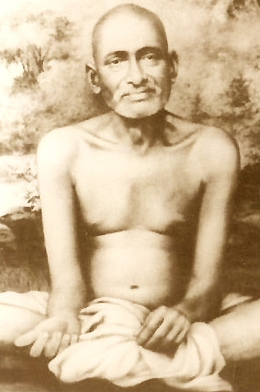
Miracles
- One day Maharaj strayed away to a village named Adgaon. At about midday, when the sun was at its peak, he approached a farmer cultivating his land and requested the drinking water that the farmer had with him. The farmer, named Bhaskar Patel, thought that he was one of the common types of mendicant sadhus and started rebuking him, saying that he would not share a drop of water, which he had carried from home a sadhu who is a parasite on society. Maharaj only smiled without any reaction and slowly walked towards what looked like an old well. Bhaskar Patel again started teasing him from behind, saying that it is a dry well and how any fool can get water from there. Maharaj reached the well, meditated for a few moments, and soon the well, which had been dry for about twelve years, filled up with clean water. He quenched his thirst with this water. Seeing this miracle, Bhaskar Patel realised that this was no ordinary man and profusely apologised for his intemperate behavior. Seeing the plight of Bhaskar, Patel moved Maharaj, who told him that he had created water for him in the well so that Patel does not have to carry water from the village strenuously every day for cultivation or drinking.
- Once Maharaj, on invitation from Bankatlal, went to his farmland to eat corn stalk. Baba, along with a group of devotees, sat under a tree, lit a fire, and roasted the corn. Nobody had seen that there was a honey beehive on the tree. As the smoke from the fire reached the hive, the honeybees came out in swarms and started stinging everybody. Except for Maharaj, all devotees ran away. The honeybees, after that, settled on the body of Maharaj, who continued to stay unmoved in his usual composure. Bankatlal witnessed this from a distance and was alarmed by the plight of Maharaj. When he approached Maharaj to render help, Maharaj addressing the honeybees, said, ‘You now go back to your place. My dear devotee Bankatlal should suffer no pain.’ No sooner had he uttered these words or the entire swarm of honeybees returned to the hive. The devotees, on return, saw that Baba’s whole body was full of stings. No ordinary person can quietly bear the stinging of a swarm of honeybees. All of them started thinking that Maharaj must be in pain. Seeing their plight, Shri Gajanan Maharaj gave a smile and took a deep breath. At once, all the stings fell out of his body in the hundreds.
- One day Maharaj went to the Nilakanth temple near the village and desired to stay there. Khandu Patil built a palm cottage for him, and people started visiting the place. Once a group of Gossains (a type of Sadhu) claiming to be the disciples of Brahmin Guruji reached the place where Baba was staying. The pretentious Sadhus demanded halwa, puri (a variety of food in India), and ganja from Patil. They also told him that he would get more virtue by serving a mad and naked person like Gajanan Maharaj.
After taking his food, to prove his superiority over Maharaj, the group leader, Brahmagiriji, started lecturing on Bhagavad-Gita to draw people’s attention. He began to explain, ‘Nainam chindanti Sastrani, Nainam Dahati Pavakam’- meaning ‘neither weapons can destroy the soul nor can fire burn it.’ Despite his efforts, people gathered around Gajanan Maharaj, who was smoking his Chillum (clay tobacco pipe) sitting on a wooden bed right opposite Brahmagiriji. His ego was hurt, and he became irate due to the absence of proper public appreciation and attention.
In this situation, a strange thing happened. The bed on which Maharaj was sitting suddenly caught fire. As the fire rose, the disciples of Maharaj requested him to get out of the fire and also started arranging for water. Maharaj said that neither water should be used to extinguish the fire nor would he get off the burning bed. Addressing Brahmagiriji, who was enjoying the sight, Maharaj said, ‘Since you have been telling people for the last one hour that neither weapon can destroy, nor fire can burn the soul, please come and prove it by sitting on this fire.’ Hearing this, Brahmagiriji did not react but tried to avoid the situation. Then Maharaj asked a physically strong disciple to catch hold of Brahmagiriji and bring him before Maharaj. His ego was shattered, and he repented not only for his behavior but also for his pretentiousness. Maharaj pardoned him and advised him on the path to be followed for spiritual upliftment.
- Shri Gajanan Maharaj had many disciples and devotees. Among them, Pitambar Shimpi was very dear to him. This was a reason for other devotees being jealous of Pitambar. Once, because of a minor incident related to Pitambar, there was a rift among devotees, and as a result, Maharaj asked Pitambar to leave him. With a heavy heart, Pitambar reached Kondoli village. However, no one in Kondoli gave him recognition as a Gajanan Maharaj devotee. Instead, he told him, ‘If you are a true Gajanan Maharaj devotee, prove it to us by creating leaves on the dried Mango tree’; this was to challenge Pitambar. Pitambar tried to make them understand, but no one was in a mood to listen. Pitamber then sent a heartfelt prayer to his Guru, Shri Gajanan Maharaj, chanted his name, and a miracle happened. Delicate green leaves started sprouting from the dry tree, and it became all green instantly. They praised Pitambar and Shri Gajanan Maharaj. Pitambar stayed at Kondoli permanently. This event took place in 1909.
- Shri Gajanan Maharaj once reached Akot to meet Shree Narsinghji Maharaj. Shree Gajanan Maharaj was sitting on the parapet of a well near Shree Narsingji Maharaj’s math with his legs dangling inside the well. Shri Gajanan Maharaj was continuously staring inside the well, to which Shri Narsingji asked, ‘Gajanana, what are you doing?’ Gajanan Maharaj replied, ‘The water in this well is from all holy rivers, I wish to have a sacred bath from the waters of these rivers, and they should come out and give me a sacred bath.‘ Hearing him say so, some critics were astonished and started laughing. At that point, a miracle happened; the well water came up gushing like a fountain and poured on Shri Gajanan Maharaj and others. Looking at this not only the believers but also the critics enjoyed the bath from the waters of the holy rivers.
- Shri Gajanan Maharaj was very fond of his ‘chillum.’ Chillum is a smoking pipe originating in India made out of terracotta material. One day, early in the morning, Maharaj had the urge to smoke his ‘chillum’ but did not have fire to ignite it. When his disciples went to a goldsmith Janakiram, he refused to given them live coals. Yet Shri Gajanan Maharaj was able to ignite his ‘chillum’ without coals. Maharaj had asked for live coals because he wanted to test Janakiram’s willingness to respond to his requests. A few days later, on the occasion of the festival of Akshaya Tritiya, Janakiram had invited some of his friends to his house for a feast. When the guests were served ‘chinchawani,’ a sweet dish made out of tamarind, they found that it was infested with worms. Disgusted, all guests left Janakiram’s house. Janakiram realised that this untoward incident had taken place because he had refused to give live coals to Shri Gajanan Maharaj. Janakiram accepted his mistake, and as soon as he did that, all the worms disappeared within the next few minutes.
- In Shegaon lived a wrestler called Hari Patil. On hearing about Shri Gajanan Maharaj’s miraculous deeds, he challenged him to a wrestling match. Shri Gajanan Maharaj defeated Hari Patil with such ease that Hari Patil was forced to swallow his pride. Slighted by this event, Hari Patil’s sons tried to beat Maharaj with sugarcane sticks inside a Hanuman temple. Strangely there were no signs of the thrashing on Maharaj’s body. Maharaj simply took those sticks and squeezed them with his hands, and extracted sugarcane juice from them.
- Another villager called Janrao was cured of his illness by having ‘tirtha,’ holy water, given to him by Shri Gajanan Maharaj. Within two days, he got rid of his ailment, much to the surprise of his doctor!
- Similarly, Lakshman Ghude, a resident of Karanja village, was terminally ill. He was brought to Shegaon to seek Maharaj’s blessings. Maharaj gave him a mango. Lakshmana consumed it against the advice of his doctor and was completely cured.
- A few years later, when the plague epidemic struck the state of Maharashtra, Maharaj’s disciple Pundalik Bhokrey, who was a victim of the plague, visited Shegaon looking for a cure. Shri Gajanan Maharaj just touched Pundalik’s armpit with his thumb, and in two days, Pundalik’s fever went down, and he was completely cured. Shri Gajanan Maharaj then gave his wooden slippers to Pundalik to install them in a shrine and propagate Maharaj’s message of devotion and worship to the Almighty.
- Besides these events, Shri Gajanan Maharaj exhibited his divine spirit by curing a leprosy patient, by making a dead dog come alive, by decreasing the duration of punishment given to his devotee by asking him to eat ‘zunkha bhakar,’ etc.
- It is believed that Shri Gajanan Maharaj, who had conquered all his senses, traveled in the ladies’ compartment in a train at will. Several such events are mentioned in the holy book ‘Shri Gajanan Vijay.’
Many other recent day miracles can be found here – Devotee’s Experiences – GAJANAN MAHARAJ AMERICA DEVOTEES PARIVAR (A NON PROFIT ORGANIsATION)
Contemporary Masters
- Shri Akkalkot Maharaj: Both Gajanan Maharaj and Sai Baba of Shirdi were under His spiritual guidance before they became known as Saints par excellence in their own right.
- Shri Maniram Baba of Baggi
- Shri Narasing Maharaj of Akot
Shri Shirdi Sai Baba: Sai Baba was in mourning on the day Gajanan Maharaj left his body. Late Shri Dadasaheb Khaparde had told that Sai Baba wept profusely when Gajanan Maharaj breathed his last. ‘My life breath is leaving me — a great part of my soul is giving up my body.‘ These were the words of sorrow uttered by Sai Baba. It is said that the work of Gajanan Maharaj devolved onto Sai Baba, and the latter had taken the responsibility of looking after all those who were near the Maharaj. Sai Baba shaved off his head in mourning when Maharaj attained Mahasamadhi on September 8, 1910.
Holy Sites and Pilgrimages
Shri Gajanan Maharaj Sansthan, Shegaon
http://www.gajananmaharaj.org/sgmsenglish/samadhimandir.htm
The Sansthan (temple management) came into existence in 1908 in the holy presence of Shree Maharaj. Because Shri Maharaj had foretold ‘Ya Jagi Rahil Re’ (meaning – it will be at this place) hinted at the specific location and day for his Samadhi.
Shri’s Samadhi Temple has been built in the most attractive marble stones. Devotees can have a distant glimpse of the idol of Lord Gajanana through an arrangement called ‘Mukh Darshan’ or can go directly through the tunnel to pray and have a glimpse of Shri’s idol very closely. The precious space near the idol in Gabhara enables the devotees to pray and have a soothing glimpse of the omnipotent spiritual idol of Lord Gajanan. The Samadhi temple’s other part has various sculptures of Gods and Goddesses carved in an exquisite manner.
The rules directed by Shri Maharaj in the first meeting of trustees are observed even today.
1) Nobody should touch the idol of Shru Maharaj.
2) Female devotees should use the entrance gate in the West; male devotees should use the gate in the East while coming for Darshan.
3) Female devotees should not stay in the temple during the night; others should not stay for more than three days.
4) Do not touch money, do not store it, and do not stop the journey.
5) One volunteer should be exclusively appointed to serve drinking water to the devotees who visit the temple. That volunteer should be given an honorarium of three rupees.
Altogether there are nine rules. From the very first day of its establishment, all decisions were finalised unanimously. Shegaon temple has a great tradition of Service, and Maharaj never preferred Guru, Shishya, Gadi Parampara [Guru – Disciple and taking and handing over the authorities].
The devotees were not allowed to enter in the Gabhara – the main sanctum sanctorum [for darshan or to offer Naivaidya, i.e., food offered to Lord], to maintain the purity.
Holy places to visit in Shegaon – http://www.gajananmaharaj.org/sgmsenglish/placestovisit.htm
Other temples, both India & abroad: https://en.wikipedia.org/wiki/Gajanan_Maharaj_Temple
Bibliography
Shri Gajanan Maharaj Sansthan has published a most invaluable holy book, Shri Gajanan Vijay Grantha (The biography on the incarnated holy life of Shri), written most uniquely and beneficially by the great Sant Kavi, Hari Bhakta Parayan Shri Dasganu Maharaj. This Grantha (Shri Gajanan Vijay) is the original book published by the Sansthan on the holy life of Shree Maharaj. This sacred book is translated and published in Hindi, English, Gujarati, Kannada, and Telugu languages.
https://shreegajanangunjan.org/index.php/gajanan-vijay-granth/
OCEAN OF MERCY-DIVINE EXPERIENCES OF GAJANAN MAHARAJ
https://www.amazon.in/OCEAN-MERCY-DIVINE-EXPERIENCES-GAJANAN-MAHARAJ/dp/B07NMQB7J9
External Links
http://www.shreeswami.org/avatars/shri-gajanan-maharaj-of-shegaon/
https://en.wikipedia.org/wiki/Gajanan_Maharaj
Gajanan Maharaj Aarathi lyrics: https://www.krazzymag.com/gajanan-maharaj-aarti-lyrics/
http://www.gajananmaharaj.org/sgmsenglish/samadhimandir.htm
http://www.gajanan-shegaon.com/contemporaries.htm
https://www.gajananmaharajshegaon.com/miracles-of-gajanan-maharaj/

